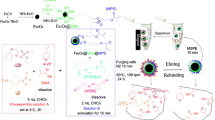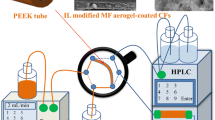Abstract
Sample preparation prior to chromatographic separation plays an important role in the analytical process. To avoid time-consuming and manual handling sample-prep, automated on-line techniques such as on-line SPE-HPLC are therefore preferred. In this study, two different on-line extraction approaches for mycotoxin/endocrine disruptor zearalenone (ZEA) determination using either molecularly imprinted polymer (MIP) with selective cavities and binding sites for extraction or a reversed-phase sorbent C18 providing non-selective interactions have been developed, validated, and compared. The validation characteristics were compared and the two methods were evaluated as being almost equal in terms of linearity, repeatability, precision, and recovery. Recoveries were in the range of 99.0–100.1% and limits of detection were found the same for both methods (1.5 μg L−1). Method precision calculated for spiked beer samples was better for C18 sorbent (2.5 vs. 5.4% RSD). No significant differences in the selectivity of either extraction method were observed. The possible reasons and further details associated with this finding are discussed. Finally, both validated methods were applied for the determination of ZEA contamination in beer samples. Due to ZEA’s native fluorescence, chromatographic separation with fluorimetric detection (λex = 270 nm and λem, = 458 nm) was selected.

Determination of zearalenone in beer using an on-line extraction chromatography system.




Similar content being viewed by others
References
Fink-Gremmels J, Malekinejad H. Clinical effects and biochemical mechanisms associated with exposure to the mycoestrogen zearalenone. Anim Feed Sci Technol. 2007;137:326–41.
Andersson AM, Bay K, Frederiksen H, Skakkebæk NE. Endocrine disrupters: we need research, biomonitoring and action. Andrology. 2016;4:556–60.
Shier WT, Shier AC, Xie W, Mirocha CJ. Structure-activity relationships for human estrogenic activity in zearalenone mycotoxins. Toxicon. 2001;39:1435–8.
Tiemann U, Tomek W, Schneider F, Vanselow J. Effects of the mycotoxins α- and β-zearalenol on regulation of progesterone synthesis in cultured granulosa cells from porcine ovaries. Reprod Toxicol. 2003;17:673–81.
Zinedine I, Soriano JM, Moltó JC, Mañes J. Review on the toxicity, occurrence, metabolism, detoxification, regulations and intake of zearalenone: an oestrogenic mycotoxin. Food Chem Toxicol. 2007;45:1–18.
Wang YC, Deng JL, Xu SW, Peng X, Zuo ZC, Cui HM, et al. Effects of zearalenone on IL-2, IL-6, and IFN-휸 mRNA levels in the splenic lymphocytes of chickens. Sci World J. 2012;2012:1–5.
Pietsch C, Junge R, Burkhardt-Holm P. Immunomodulation by zearalenone in carp (Cyprinus carpio L.). Biomed Res Int. 2015;2015:1–9.
Ryu D, Hanna MA, Eskridge KM, Bullerman LB. Heat stability of zearalenone in an aqueous buffered model system. J Agric Food Chem. 2003;51:1746–8.
Scott PM. Mycotoxins transmitted into beer from contaminated grains during brewing. J AOAC Int. 1996;79:875–82.
Odhav B, Naicker V. Mycotoxins in South African traditionally brewed beers. Food Addit Contam. 2002;19:55–61.
Bauer JI, Gross M, Gottschalk C, Usleber E. Investigations on the occurrence of mycotoxins in beer. Food Control. 2016;63:135–9.
Peters J, van Dam R, van Doorn R, Katerere D, Berthiller F, Haasnoot W, et al. Mycotoxin profiling of 1000 beer samples with a special focus on craft beer. PLoS One. 2017; https://doi.org/10.1371/journal.pone.0185887.
Habler K, Gotthardt M, Schüler J, Rychlik M. Multi-mycotoxin stable isotope dilution LC-MS/MS method for Fusarium toxins in beer. Food Chem. 2017;218:447–54.
European Commission. Regulation no 1126/2007 amending regulation (EC) no 1881/2006 setting maximum levels for certain contaminants in foodstuff as regards Fusarium toxins in maize and maize products. Off J Eur Union. 2007;L255:14–7.
Kwaśniewska K, Gadzała-Kopciuch R, Cendrowski K. Analytical procedure for the determination of zearalenone in environmental and biological samples. Crit Rev Anal Chem. 2015;45:119–30.
Afzali D, Fathirad F. Determination of zearalenone with a glassy carbon electrode modified with nanocomposite consisting of palladium nanoparticles and a conductive polymeric ionic liquid. Microchim Acta. 2016;183:2633–8.
Hsieh HY, Shyu CL, Liao CW, Lee RJ, Lee MR, Vickroy TW, et al. Liquid chromatography incorporating ultraviolet and electrochemical analyses for dual detection of zeranol and zearalenone metabolites in mouldy grains. J Sci Food Agric. 2012;92:1230–7.
Liu N, Nie D, Tan Y, Zhao Z, Liao Y, Wang H, et al. An ultrasensitive amperometric immunosensor for zearalenones based on oriented antibody immobilization on a glassy carbon electrode modified with MWCNTs and AuPt nanoparticles. Microchim Acta. 2017;184:147–53.
Xu W, Qing Y, Chen S, Chen J, Qin Z, Qiu JF, et al. Electrochemical indirect competitive immunoassay for ultrasensitive detection of zearalenone based on a glassy carbon electrode modified with carboxylated multi-walled carbon nanotubes and chitosan. Microchim Acta. 2017;184:3339–47.
Zhan S, Huang X, Chen R, Li J, Xiong Y. Novel fluorescent ELISA for the sensitive detection of zearalenone based on H2O2-sensitive quantum dots for signal transduction. Talanta. 2016;158:51–6.
Bozkurt SS, Işık G. Ionic liquid based dispersive liquid–liquid microextraction for preconcentration of zearalenone and its determination in beer and cereal samples by high-performance liquid chromatography with fluorescence detection. J Liq Chromatogr Relat Technol. 2015;38:1601–7.
Lucci P, Derrien D, Alix F, Pérollier C, Bayoudh S. Molecularly imprinted polymer solid-phase extraction for detection of zearalenone in cereal sample extracts. Anal Chim Acta. 2010;672:15–9.
Drzymala SS, Weiz W, Heinze J, Marten S, Prinz C, Zimathies A, et al. Automated solid-phase extraction coupled on-line with HPLC-FLD for the quantification of zearalenone in edible oil. Anal Bioanal Chem. 2015;407:3489–97.
Porto-Figueira P, Camacho I, Câmara JS. Exploring the potentialities of an improved ultrasound-assisted quick, easy, cheap, effective, rugged, and safe-based extraction technique combined with ultrahigh pressure liquid chromatography-fluorescence detection for determination of zearalenone in cereals. J Chromatogr A. 2015;1408:187–96.
Briones-Reyes D, Gómez-Martinez L, Cueva-Rolón R. Zearalenone contamination in corn for human consumption in the state of Tlaxcala, Mexico. Food Chem. 2007;100:693–8.
Zöllner P, Berner D, Jodlbauer J, Lindner W. Determination of zearalenone and its metabolites α- and β-zearalenol in beer samples by high-performance liquid chromatography-tandem mass spectrometry. J Chromatogr B Biomed Sci Appl. 2000;738:233–41.
Mausia T, De Smet D, Guorun Q, Van Peteghem C, Zhang D, Wu A, et al. Molecularly imprinted polymers as specific adsorbents for zearalenone produced by precipitation polymerization and applied to mycotoxin production. Anal Lett. 2011;44:2633–43.
Rempelaki IE, Sakkas VA, Albanis TA. The development of a sensitive and rapid liquid-phase microextraction method followed by liquid chromatography mass spectrometry for the determination of zearalenone residues in beer samples. Anal Methods. 2015;7:1446–52.
Hu X, Hu R, Zhang Z, Li P, Zhang Q, Wang M. Development of a multiple Immunoaffinity column for simultaneous determination of multiple mycotoxins in feeds using UPLC-MS/MS. Anal Bioanal Chem. 2016;408:6027–36.
Vaclavikova M, MacMahon S, Zhang K, Begley TH. Application of single Immunoaffinity clean-up for simultaneous determination of regulated mycotoxins in cereals and nuts. Talanta. 2013;117:345–51.
Zhao Z, Liu N, Yang L, Deng Y, Wang J, Song S, et al. Multi-mycotoxin analysis of animal feed and animal-derived food using LC-MS/MS system with timed and highly selective reaction monitoring. Anal Bioanal Chem. 2015;407:7359–68.
Jettanajit I, Nhujak T. Determination of mycotoxins in brown rice using QuEChERS sample preparation and UHPLC-MS-MS. J Chromatogr Sci. 2016;54:720–9.
Zhao KX, Ge BK, Chen XY, Xu H. Determination of 10 mycotoxins in Chinese herbs and Chinese medicines by liquid chromatography-tandem mass spectrometry using on-line immunoaffinity purifying. Chin J Anal Chem. 2011;39:1341–6.
Laganà I, Bacaloni A, Castellano M, Curini R, De Leva I, Faberi A, et al. Sample preparation for determination of macrocyclic lactone mycotoxins in fish tissue, based on on-line matrix solid-phase dispersion and solid-phase extraction cleanup followed by liquid chromatography/tandem mass spectrometry. J AOAC Int. 2003;86:729–36.
Habler K, Rychlik M. Multi-mycotoxin stable isotope dilution LC-MS/MS method for Fusarium toxins in cereals. Anal Bioanal Chem. 2016;408:307–17.
Ferreira I, Fernandes JO, Cunha SC. Optimization and validation of a method based in a QuEChERS procedure and gas chromatography–mass spectrometry for the determination of multi-mycotoxins in popcorn. Food Control. 2012;27:188–93.
Emídio ES, da Silva CP, de Marchi MRR. Determination of estrogenic mycotoxins in environmental water samples by low-toxicity dispersive liquid–liquid microextraction and liquid chromatography–tandem mass spectrometry. J Chromatogr A. 2015;1391:1–8.
D’Orazio G, Hernández-Borges J, Herrera-Herrera AV, Fanali S, Rodríguez-Delgado MÁ. Determination of estrogenic compounds in milk and yogurt samples by hollow-fibre liquid-phase microextraction-gas chromatography-triple quadrupole mass spectrometry. Anal Bioanal Chem. 2016;408:7447–59.
Wang YK, Zou Q, Sun JH, Wang H, Sun X, Chen ZF, et al. Screening of single-stranded DNA (ssDNA) aptamers against a zearalenone monoclonal antibody and development of a ssDNA-based enzyme-linked oligonucleotide assay for determination of zearalenone in corn. J Agric Food Chem. 2015;63:136–41.
Appell M, Mueller A. Mycotoxin analysis using imprinted materials technology: recent developments. J AOAC Int. 2016;99:861–4.
Urraca JL, Marazuela MD, Merino ER, Orellana G, Moreno-Bondi MC. Molecularly imprinted polymers with a streamlined mimic for zearalenone analysis. J Chromatogr A. 2006;1116:127–34.
González-Sálamo J, Socas-Rodríguez B, Hernández-Borges J, del Mar Afonso M, Rodríguez-Delgado MÁ. Evaluation of two molecularly imprinted polymers for the solid-phase extraction of natural, synthetic and mycoestrogens from environmental water samples before liquid chromatography with mass spectrometry. J Sep Sci. 2015;38:2692–9.
Weiss R, Freudenschuss M, Krska R, Mizaikoff B. Improving methods of analysis for mycotoxins: molecularly imprinted polymers for deoxynivalenol and zearalenone. Food Add Contam. 2003;20:386–95.
Gadzała-Kopciuch R, Cendrowski K, Cesarz A, Kiełbasa P, Buszewski B. Determination of zearalenone and its metabolites in endometrial cancer by coupled separation techniques. Anal Bioanal Chem. 2011;401:2069–78.
Ates E, Mittendorf K, Stroka J, Senyuva H. Determination of fusarium mycotoxins in wheat, maize and animal feed using on-line clean-up with high resolution mass spectrometry. Food Add Contam Part A. 2013;30:156–65.
Moein MM, Abdel-Rehim M. Molecularly imprinted polymers for on-line extraction techniques. Bioanalysis. 2015;7:2145–53.
Martín-Esteban A. Recent molecularly imprinted polymer-based sample preparation techniques in environmental analysis. Trends Environ Anal Chem. 2016;9:8–14.
Acknowledgements
This work was supported by the Charles University Grant Agency, project No 726316, and by the project GAČR, no 15-10781S. I. Lhotská gratefully acknowledge the financial support of the project of specific research of Charles University, project no SVV 260 412. This work was also supported by the STARSS project (Reg. No. CZ.02.1.01/0.0/0.0/15_003/0000465) co-funded by the ERDF.
Author information
Authors and Affiliations
Corresponding author
Ethics declarations
Conflict of interest
The authors declare that they have no conflict of interest.
Additional information
Published in the topical collection Euroanalysis XIX with guest editors Charlotta Turner and Jonas Bergquist.
Electronic supplementary material
ESM 1
(PDF 105 kb)
Rights and permissions
About this article
Cite this article
Lhotská, I., Gajdošová, B., Solich, P. et al. Molecularly imprinted vs. reversed-phase extraction for the determination of zearalenone: a method development and critical comparison of sample clean-up efficiency achieved in an on-line coupled SPE chromatography system. Anal Bioanal Chem 410, 3265–3273 (2018). https://doi.org/10.1007/s00216-018-0920-2
Received:
Revised:
Accepted:
Published:
Issue Date:
DOI: https://doi.org/10.1007/s00216-018-0920-2




